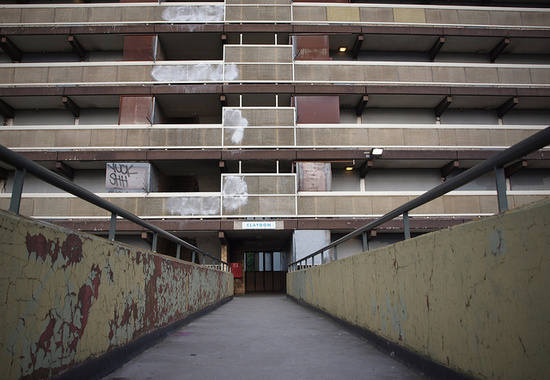Sink estate regeneration plans
Former Prime Minister David Cameron announced new pledges in 2015 to tackle social deprivation and poverty by transforming ‘sink estates’ around the country.
Writing in the Sunday Times on 10 January 2015, Cameron affirmed his intention to deliver a package of measures aimed at radically redeveloping 100 housing estates, replacing them with high-quality homes or in some cases knocking them down altogether.
In what he labelled ‘an all-out assault on poverty and disadvantage’, Cameron said that a new £140 million fund would be set up to enable the regeneration scheme to begin, providing for planning, temporary housing and early construction costs.
A new Estate Regeneration Advisory Panel will be established, chaired by Lord Heseltine, with a deadline to report by this year’s Autumn Statement. Heseltine served in Margaret Thatcher’s government and was the minister responsible for the rejuvenation of Liverpool and London docklands in the 1980s.
The first task of the new panel will be to compile a list of post-war estates that would best benefit from redevelopment. Existing tenants and homeowners have been promised a set of binding guarantees protecting their homes.
Speaking on the Andrew Marr Show, Cameron said that rather than the proposals leading to a decrease in social housing at affordable rents, many more would be built with people being given the chance to buy them via the extended right-to-buy scheme.
In his written article, Cameron highlighted the criminality that has become entrenched and allowed the flourish as a result of the design of some estates, describing ‘brutal high-rise towers and dark alleyways that are a gift to criminals and drug dealers. The police often talk about the importance of designing out crime, but these estates actually designed it in’. He pointed to statistics showing that almost 3-quarters of those convicted after the 2011 riots were inhabitants of such estates.
The PM’s announcement was timed to coincide with a report from property advisor Savills, showing that a new regeneration strategy could serve as the catalyst for hundreds of thousands of new homes being built in London, as well as country-wide.
Yolande Barnes, Savills Research Director, said: “What the Savills research shows is that housing estates can deliver more homes and be made into better neighbourhoods by re-integrating them into the wider street network and creating or repairing the streetscape. This creates more highly valued neighbourhoods.”
You can read David Cameron’s full statement here.
The statement coincided with publication of a Savills Research Report to the Cabinet Office, Completing London’s Streets, How the regeneration and intensification of housing estates could increase London’s supply of homes and benefit residents. This compared two methods of redeveloping social housing estates in London; replacing the existing site with new blocks and towers in a similar layout but higher density (contemporary regeneration) or reintegrating the estates into the surrounding urban fabric (complete streets). They found that the complete streets approach creates greater opportunities for mixed use development and integration into the wider city, resulting in better life chances.
The 17-strong panel was named on 9 February 2016 and included; Jane Duncan, president of the Royal Institute of British Architects (RIBA), Peter Vernon, chief executive of Grosvenor Estates, Councillor Ravi Govindia, leader of Wandsworth Council and Tony Pidgley, chief executive of Berkeley Homes. Ref Gov.uk 9 February.
[edit] Find out more
[edit] Related articles on Designing Buildings Wiki
- Ballymun mass housing and regeneration.
- Brownfield land.
- CIBSE Case Study Thamesmead Estate Refurbishment.
- Enterprise zones.
- Estate Regeneration National Strategy.
- Eyesore.
- Gentrification.
- Housing contribution to regeneration.
- Housing zones.
- Land banking.
- Local development orders.
- Masterplanning.
- Placemaking.
- Regeneration.
- Space, Hope and Brutalism.
- Thamesmead Housing Estate.
- U+I.
- Urban decay.
- Well-being and Regeneration: Reflections from Carpenters Estate.
Featured articles and news
Infrastructure that connect the physical and digital domains.
Harnessing robotics and AI in challenging environments
The key to nuclear decommissioning and fusion engineering.
BSRIA announces Lisa Ashworth as new CEO
Tasked with furthering BSRIA’s impressive growth ambitions.
Public buildings get half a million energy efficiency boost
£557 million to switch to cleaner heating and save on energy.
CIOB launches pre-election manifesto
Outlining potential future policies for the next government.
Grenfell Tower Inquiry announcement
Phase 2 hearings come to a close and the final report due in September.
Progress from Parts L, F and O: A whitepaper, one year on.
A replicated study to understand the opinion of practitioners.
ECA announces new president 2024
Electrical engineer and business leader Stuart Smith.
A distinct type of countryside that should be celebrated.
Should Part O be extended to existing buildings?
EAC brands heatwave adaptation a missed opportunity.
Definition of Statutory in workplace and facilities management
Established by IWFM, BESA, CIBSE and BSRIA.
Tackling the transition from traditional heating systems
59% lack the necessary information and confidence to switch.
The general election and the construction industry
As PM, Rishi Sunak announces July 4 date for an election.
Eco apprenticeships continue help grow green workforce
A year after being recognised at the King's coronation.
Permitted development rights for agricultural buildings
The changes coming into effect as of May 21, 2024.























Comments
This building is Grade II* listed and is not on a sink estate - poor choice of image.
Good point, changed accordingly. Thanks for highlighting, Ed.